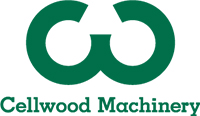Mills incorporating waste paper in their process has since long struggled with many different issues. The more obvious are the actual contaminants accompanying the waste paper.
However more recently the fibre properties have started to degrade as well as fluctuate more. This due to, among other things, less sorting and more mixing of different grades which basically makes it impossible for the mills to source the correct furnish. Companies spend significant extra time and money to secure a furnish mix that will not only give them needed end quality but also keep the production upsets at a minimum.
As the tacky contaminants reach the machine there will be downtime to handle wire, felt and doctor blade changes and cleaning. It will also many times mean a heightened reject rate of the finished product and/or defects lowering the value of the same. Mills also tend to have to run higher basis weights on their specific grades to meet strength targets, this mainly due to a fibre source with less physical strength and not enough installed refining capacity to correct it.
The solution to improve this situation lies with the KRIMA HDS which in one single system does what would take a complete stock preparation and approach flow upgrade to accomplish.
The KRIMA HDS
Paper is a product which all of us are using on a daily basis. As raw material and energy prices continue to fluctuate and rise it becomes more important to have the correct tools with which to handle these changes. The KRIMA Hot Dispersion is one important part in a modern stock preparation plant and is crucial to be able to meet today’s demands for quality. The target of dispersion is to disperse, distribute, the contaminants in the waste paper to a non-visible size in both an economic and for the fibre properties developing way.
With a vast number of installations it is shown that Hot Dispersion makes perfect economic sense with a short return of investment.
The HDS is the solution to optimize the performance, flexibility and operating cost on varying degrees of raw material and required results. It has a capability to operate at temperatures up to 120°C (248°F). As the most advanced system the HDS produces the best dispersing result on all kind of dispersible contaminants in waste paper. It is also the most flexible dispersing system. The discharge of the Screw Press KSR does not need to be pressurized as the downstream Plug Screw is designed to seal the system. Retention time through the system is 2 minutes which is important to make sure all fibers as well as contaminants are uniformly heated all the way through, it is also enough for in-line bleaching and a high reduction of spores and bacteria in the pulp.
Dirt and Specks
Due to the temperature, the high consistency at plus 30% and the design of the HDS the dirt reduction efficiency will be very high. Normally it will be in the 85 to 95% range depending on raw material quality and previous treatment.
The fibers and contaminants are heated to a point where they are soft and flexible. This will enable a stronger dispersion without the risk of excessive fiber shortening and freeness drops. The dispersion of dirt and specks is made possible due to the fiber to fiber friction as well as friction against the disperser plates. The HDS will ensure full and uniform heating of all fibers and contaminants, this will in turn guarantee the efficiency.
 Speck reduction before and after.
Speck reduction before and after.
Tacky contaminants
The high temperature at up to +120 degrees Celsius plays an even more important role in dispersion of tacky contaminants. On top of that high consistency at plus 30% and the design of the Disperser makes the reduction efficiency of tacky contaminants outstanding.
The contaminants are heated to a point where they are soft and can be dispersed over a large amount of fiber surfaces with fiber to fiber friction and friction against the disperser plates. The HDS capability of uniform heating, due to retention time, is a crucial part in maximizing the efficiency.
After passing the plates the pulp is diluted and cooled, this will stabilize the contaminants in a non-tacky state. Later increases in temperature will not reactivate the tackiness and the contaminants will go with the paper through the machine without adhering to wires, felts, rolls or dryer cans.
The installation of a HDS will lead to higher yield, through less reject and less fines creation, as well as less additives for stickie control on the machine and less down time for solvent cleaning.
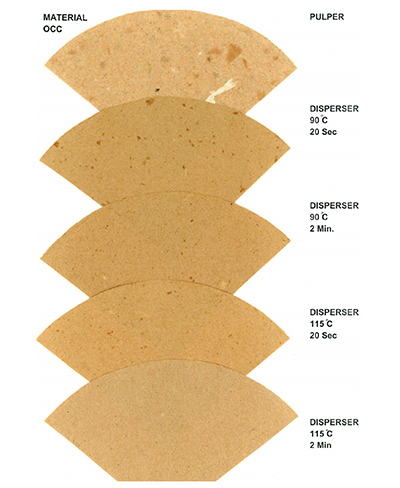 Importance of time and temperature.
Importance of time and temperature.
Bacteria and Spores
Retention time at high temperatures and high consistency at plus 30% sets the reduction of bacteria and spores at a very high level. Normally it will be some 99%, thus dramatically reducing the need for biocides etc.
Physical Properties
Further developments has added the benefit of significant fibre development in regards to strength.
This is made possible due to the treatment at high consistency and temperature. The flexibility of the fiber under these conditions allows for a controlled defibrillation that results in very high strength development without excess creation of fines.
In full scale installations as well as pilot plant trials, developments on average of:
+40% tensile, +60% Burst and +20% Tear has been experienced.
The energy needed to reach these levels of strength development is very low. The disperser consumes about 35-40 kWh/MTon (1.75 – 2.0 hPd/STon). This energy can easily be saved in the low consistency refining stages.
Mills today see that with a Krima they can compensate for the lower quality fiber source and keep their raw material costs in check. In many cases mills are today adding basis weight to the sheet to keep specifications and compensate for lower quality fibre. By adding a HDS system, not only will a clean sheet be produced but the strength will be improved so that the basis weight can be reduced back to normal levels again.
Energy
There is a widespread misconception that Dispersion uses a lot of energy. That might be true for some technologies, new and old, but when it comes to the HDS nothing could be further from the truth. There are basically 2 energy inputs into the system electrical and steam. The electrical was mentioned above and the energy used in the HDS is almost always saved in refiners and deflakers.
As for the steam it is important to mention that the location of the HDs is key. Located at the very end of stock preparation, with minimal storage time before the machine, the uniformly heated pulp will aid in drainage and pressing allowing for significant savings in dryer stages and chests. The HDS will also be a water loop divider keeping the stock prep water from the machine water and thus keeping machine water at higher quality and more stable temperatures.
After all in the HDS the heating is performed, at high consistency, in a fully sealed and insulated system making it far more efficient than a chest or hood.
Uniformity and forming
It is rather common that small fiber bundles not separated in traditional stock preparation systems make their way onto the machine. This leads to uneven forming which impacts strength and uniformity especially so on lower basis weights.
The HDS is very efficient at separating these bundles and clusters giving the mill a better opportunity to manufacture a better, stronger and more uniform product.
This deflaking capability of the Krima Disperser is well shown in broke handling systems running wet strength and coated broke.
Broke handling
Handling wet strength broke normally means use of steam and chemicals. This leads to an energy and environmental impact not acceptable by most producers today. If a Krima HDS is installed in the final parts of the stock prep a side stream of broke can be fed to it. By cutting out chemicals and steam in the pulping stage as well as shortening pulping batch times, by 4 to 8 times, a pump-able high flake content pulp is produced. This is then fed to the Krima HDS for full deflaking without any need of chemical additives. This results in a full yield and very economical broke handling.
Benefits and Savings
Savings and improvements can be seen in among other areas:
- Furnish cost (normally a significant factor).
- Due to a very efficient sequence Y+P bleaching significant chemical savings will be realized.
- Yield (there are no/minimal rejects in dispersion).
- Solvent chemical usage on machine for cleaning.
- Biocide usage as temperature will eliminate bacteria and spores.
- Cut/elimination of refining energy due to excellent strength development across the Disperser.
- Less rejected product from machine due to more stable quality and “police” function of the disperser.
- Improved overall quality and brightness
Case Study 1
A North American board mill did their due diligence including trials at Cellwood’s pilot facilities in Sweden. The results achieved at the trials were the base for the decision to install a complete KRIMA HDS. The type of board produced was severely affected by tacky contaminants and especially bleed through spots that showed up in dryer sections as well as later in converting. After the HDS installations these problems were eliminated. Another positive effect seen on the furnish, 80% OCC and 20% Mixed Waste, was strength development. Significant increases in several areas among the more important +40% Tensile Index development, this at the same time as a 17% increase in Tear.
This development led to fiber savings as they could reduce the basis weight on the production it also made it possible to back off low consistency refiners.
The system continuously delivers top quality results with high availability and very low maintenance needs and costs.
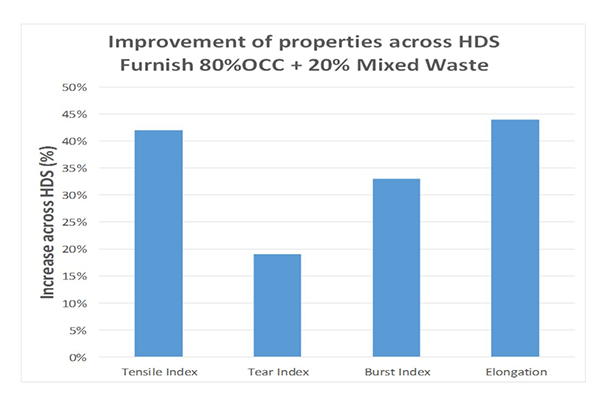 Graph showing strength development in board mill.
Graph showing strength development in board mill.
Case Study 2
A North American tissue mill, producing a wide variety of wet strength towel qualities, had issues with high energy usage as well as high chemical, hypochlorite, consumption. On top of that significant amounts of steam was used to be able to pulp these wet strength grades. Due to the environmental permits they were restricted in the amount of broke that could be processed as each ton required a lot of hypochlorite. After trials with Cellwood a Krima UCD dispersing system was installed. Today they are running very short batch times in the pulper just enough to be able to pump the flaky pulp to the Krima. The UCD system then treats the pulp and produces a completely de-flaked pulp, which can be sent directly to their separate machines. This gives the mill a big flexibility in broke handling and takes away the need to run it through their regular stock preparation. Other benefits are lower energy levels per ton treated and the best of all no more chemicals.
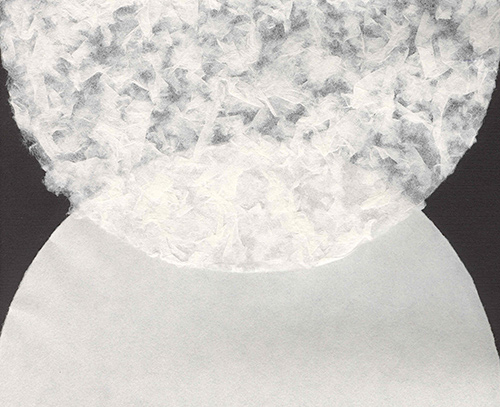 Wet strength towel before and after UCD.
Wet strength towel before and after UCD.
Case Study 3
A mill producing newsprint and fine paper was planning to convert the newsprint portion into OCC based light weight liner. The stock preparation was designed with ample cleaning and screening but very little refining. To handle the new challenges they considered installing more cleaning, screening and LC refining. In the end they decided to only install a Krima HDS to tackle all areas. It resulted in a strong sheet and as the Mill manager put it “the cleanest sheet on the market”.
A test was done by coating before and after samples to show the bleed through rate and there was a significant difference.
There are many mills planning this type of shift in their production and the HDS would be the logical choice to handle such a transition. One system, one project and problems solved.
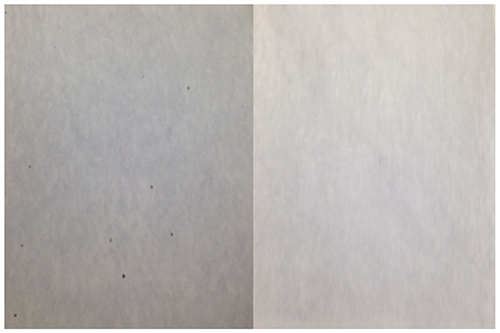 Before and after bleed through.
Before and after bleed through.
About the Author
Niklas Tunell is Area Sales Manager N&S America at Cellwood Machinery AB.
About Cellwood Machinery
Cellwood has played an important part in the development of the modern pulp and paper industry. The company is the world leading supplier of dispersing systems, which are used in the process of recycling paper waste into new paper. More than 700 system installations have been delivered to paper mills all over the world. www.cellwood.se




